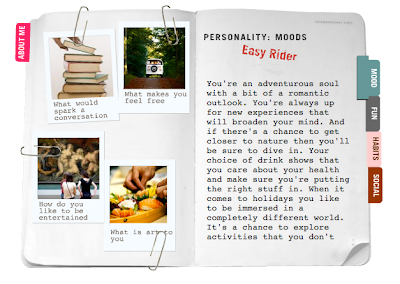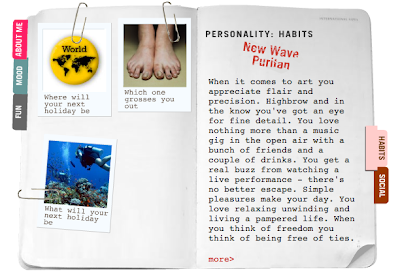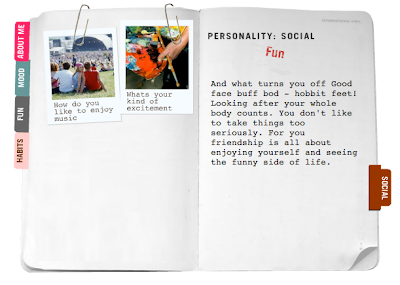



| Your Type is INFJ | |||
| Introverted | Intuitive | Feeling | Judging |
| Strength of the preferences % | |||
| 33 | 62 | 50 | 1 |
| Literature/Writer |
| Humanities |
| Web Design |
| Philosophy |
| Archaeology |
| Religious Education |
| Psychology |
| Counseling |
Counselors are scarce, little more than three percent of the population, and can be hard to get to know, since they tend not to share their innermost thoughts or their powerful emotional reactions except with their loved ones. They are highly private people, with an unusually rich, complicated inner life. Friends or colleagues who have known them for years may find sides emerging, which come as a surprise. Not that Counselors are flighty or scattered; they value their integrity a great deal, but they have mysterious, intricately woven personalities which sometimes puzzle even them.
Counselors tend to work effectively in organizations. They value staff harmony and make every effort to help an organization run smoothly and pleasantly. They understand and use human systems creatively, and are good at consulting and cooperating with others. As employees or employers, Counselors are concerned with people's feelings and are able to act as a barometer of the feelings within the organization.
Blessed with vivid imaginations, Counselors are often seen as the most poetical of all the types, and in fact they use a lot of poetic imagery in their everyday language. Their great talent for language-both written and spoken-is usually directed toward communicating with people in a personalized way. Counselors are highly intuitive and can recognize another's emotions or intentions - good or evil - even before that person is aware of them. Counselors themselves can seldom tell how they came to read others' feelings so keenly. This extreme sensitivity to others could very well be the basis of the Counselor's remarkable ability to experience a whole array of psychic phenomena.


Vector-based images generally contain well-defined elements such as curves and shapes of various colors. These elements can either be pure graphics, western alphabets or Asian characters. Each element is defined mathematically by the computer. For example, if a vector-based image contains a red dot, then information such as the location of the circle's center point, the length of its radius, and the color, red, would be the essential information for this image file.
File names for vector-based images usually consist of extensions such as *.EPS, *.AI,*CDR, or *.DWG.
Vector-based files are more suitable for illustrations that require precise measurements. They are also easily scalable due to their mathematical nature. However, the vector-based file format has its drawbacks as well. It is not good for displaying photo-realistic images such as a photograph because images of this type generally do not contain well-defined shapes and curves.
Bitmap-based images, on the other hand, do not rely on mathematical formulas to define their various elements. Each bitmap-based image is mapped into a grid. The size of the grid is based on the image's resolution. For example, a bitmap-based image of 1 inch x 1 inch with a 600 dpi resolution would be defined by a grid of 600 x 600 pixels. Hence, a bitmap-based image is like a mosaic of pixels with each pixel holding a specific color value.
Bitmap-based files are more suitable for photo-realistic images that require complex color variations. They are, however, not easily scalable because each bitmap-based image is mapped to a non-flexible grid. If a bitmap-based image were to be enlarged, it would lose its sharpness. All edges within the image would appear to be jagged.
File names for bitmap-based images usually consist of extensions such as *.PSD,*.JPG, *GIF, *.TIF, or *.BMP.
Bitmap vs. Vector, http://www.mustek.com.tw/Class/bit_vec.html 24/5
As scientists discover, metamorphosis begins. In this traumatic horror film, questioning the future relationship between man and machine becomes shrilling as the science of genetics creates artificial life. What happens when these creatures are created and then abandoned? On earth without guidance, sometimes, you need to watch your step...
A synopsis is a summary given in brief terms that covers the major points of your film. Synopses are usually more in-depth than a mere "summary", and aim to give a fair idea of the topic.
My film ultimately is a music video composed of all different footage of my pets. They are a great example of loyal, worry free creatures and wanted to put this aspect of animals into my film.
Evaluation of Film Progress
Introduction:
Has your film been edited to engage the audience initially and to establish the tone of the piece?
What are you going to do to engage the audience? Describe the sounds, lighting, shot types and effects that fit with the genre of your film and how you will incorporate these at the start of your film?
Have you carefully chosen audio to suit the pace of the project? Describe the audio and the pace.
Describe the pace of your music and the type of shots (close-up, mid, high, etc) that you will be creating to fit with the music?
I have used effects like slowing down the footage to match with slow paced parts of the audio. Also, I have zoomed in on strong audio points and zoomed out as the audio quietens.
Yes, I have included credit's at the end of my film to acknowledge my beautiful animals :) I have used an effect to make the credits similar to the famous star wars credits. I did this for a bit of fun and also because my pets names are all from the star wars films. At the start of my film i have included the artist and song title int he bottom left-hand corner to enhance the authenticity of it being a music video.
Is the film edited to appropriately suit the rhythm of the scene? Describe the use of techniques such as selective timing and length of shots (either action or sound)
Have you edited the footage to create heightened expression and audience responses? Describe how you are going to achieve this. i.e. cross dissolves, graphic matches, effects etc
Have you created links between shots and throughout the film to emotionally engage the viewer with your story ( i.e. is your film tied together through theme, colour, story, objects etc?)
Yes, the theme is simplicity and live life. The colours are organic and the characters are natural and naive.

1. What Genre will you be creating a poster for?
I will be creating a poster for a horror genre film.
2. What colour scheme would suit this particular genre?
A dark eerie colour scheme would suit this best. Reds, greens, and black and white.
3. What texures and type of shapes would best suit this genre?
Sharp shapes would suit this genre.
4. Who is the intended audience for your website?
The intended audience is going to be fellow horror appreciators.
5. Which fonts would suit your film genre?
Dripping blood fonts, or big bold block letters.
Because multimedia careers deal with appealing to large audiences, those looking to work in the field should have qualities of creativity, innovation and artistic talent. But strong communication skills are also important. Multimedia professionals often have vibrant personalities and lots of charisma, and can work well with others. These types of skills often help with work, aside from the usual skills obtained through learning, like mathematical and analytical skills, and others obtained through degrees.
The skills and abilities needed vary from job to job. While a graphic designer may need computer skills, mathematics and programming, a multimedia planner might focus more on management skills, marketing and execution of tasks. Other types of work might involve knowing what customers want and creating presentations for them, producing sound, animation or video, and knowing how to use computer programs like Flash, Dreamweaver and Photoshop.
Because multimedia is a broad term encompassing many fields, students often specialize. Animation fields can include visual design, 2D animation, 3D animation, web content, music production, sound and lighting effects, interactive and interface design and motion. Related fields include publishing, marketing, business advertising and others.
There are many multimedia degrees available through colleges and universities. These programs usually focus on computer science and aesthetics, giving students the skills needed to use advanced programs to create content, but also helping them refine the artistic talent often needed to create. Language is also important in order to build the communication skills necessary to deal with customers. Those in programming fields learn advanced mathematics and computation.
Workers usually begin in entry level positions as assistants. They may do copying and proofing, but can work their way up by demonstrating responsibility. Work environments are usually office settings with flexible hours. However, when deadlines near, the hours can also change dramatically, with workers staying late to finish the different elements and aspects of a project. Because of the stress of some projects, energetic, self-disciplined and charismatic individuals will more likely do better than others.